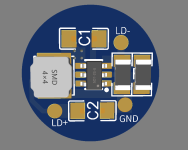loreadarkshade
Well-known member
- Joined
- Dec 14, 2020
- Messages
- 473
- Points
- 93
I have designed a 488nm and 505nm boost driver.
The driver is 15mm in diameter.
Input 3.7v batt. (3v-4.5v)
Output clamped @ 30v
Constant current at 150mA for both 488nm and 505nm (can be changed by SMD feedback shunt resistors).
These diodes are perfectly capable of being over-driven at 150mA, actually they work great at 350mA, but this is all I could get out of this setup, and honestly, it's plenty of power, while maintaining good diode life.
Let me know if this interests anyone for purchase!


The driver is 15mm in diameter.
Input 3.7v batt. (3v-4.5v)
Output clamped @ 30v
Constant current at 150mA for both 488nm and 505nm (can be changed by SMD feedback shunt resistors).
These diodes are perfectly capable of being over-driven at 150mA, actually they work great at 350mA, but this is all I could get out of this setup, and honestly, it's plenty of power, while maintaining good diode life.
Let me know if this interests anyone for purchase!





